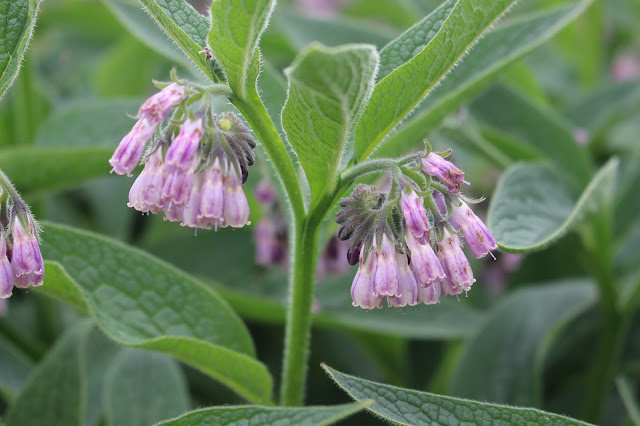That blue flower: A spring spotter's guide
As well as similar flowers, most of these plants are hairy in their nature, flower around the same time, and favour damp, shady places. Many of them are great for pollinators too, especially bees and this week's warm weather has certainly drawn them to these flowers. This makes it even more likely for these plants to be mistaken for each other and it's a great opportunity for me to put together a spotter's guide in case you find the same flowers on your outings.
Staying with green alkanet, the key features which set it apart are its relative height (around 2-3 feet in Chippenham) and the way the leaves form a rosette when looked at from above as shown in the photo (click to enlarge if needed).
This is one of the damp shade lovers, likes calcium (it'll get plenty around here!) and is a perennial, native to western Europe. It's thought to have been introduced to the UK around 1700, so it's not a native wildflower. It usually flowers from April to June.
A few yards away I found a good clump of forget-me-nots. You can see why those parents mistook the green alkanet for it, though these flowers are a lighter blue and bunched together on their stems. It's also much shorter, peeping out from the surrounding grass, with its softer, slightly more rounded leaves. This one's an annual and likely to be a garden escapee as it self-seeds freely and is a favourite companion plant to wallflowers and tulips. It appeared regularly on my allotment in the sunniest part of the plot, defying its usual favourite spots in woodland and hedgerow edges. It was quite prone to mildew there, which suggests the driest part of my plot wasn't quite to its liking. It usually flowers from April to June.
This is Brunnera 'Jack Frost' currently in bloom in my garden. It has those similar flowers and likes to hug the ground in damp shade. The key difference which sets it apart are the heart-shaped leaves, not necessarily variegated like this particular cultivar. Some sources say this is an evergreen perennial, though in my experience it tends to die down in the autumn/winter. Brunnera usually bloom from April until May.
Here's Pulmonaria officinalis, also from my garden. The Twittertalk I've seen shows this is sometimes mistaken for green alkanet, though its height and the drooping, differently shaped flowers are the giveaway that it's not. This is another shade and damp loving, ground covering perennial, which sometimes escapes from gardens. This one's attempting to do just that as it's leapt from the border into my gravel path. The books say it flowers in spring, though I often find it flowers from December onwards in my garden, where bees out on late winter sunny days are delighted to find it.
Jane Perrone wrote about comfrey being mistaken for green alkanet a while ago. Here's some Russian comfrey ('Bocking 14') from my allotment from a few years back, which shows the flowers are quite different. Its height and leaf-shape are similar, which probably accounts for the confusion. The leaf size is huge in comparison, which is why I grew it to make comfrey tea, as well as the bees loving it (as my original post shows).
You'll see a similar plant growing riverside in Chippenham, particularly in Monkton Park, though the flowers I've seen are more white, which means it's probably Symphytum officinale. Both comfreys flower from May-June until the autumn and plants die back in the winter.
My final potential green alkanet usurper is the lovely borage, a herb I was delighted to find self-sown on my allotment. This one's as tall as alkanet, but its star-like flowers are the giveaway difference. Bloom time is a little different too, usually June to September, so it's one to look out for later this year. This one hails from the Mediterranean and therefore is usually found in warmer, sunnier spots than its alkanet cousin. The flowers make a delightful addition to Pimms and have a delicate cucumber flavour. Bees adore the flowers too.
I hope you find this guide useful on your walks over the next few weeks. Which ones have you spotted on your travels?
I can't talk about blue flowers for spring without mentioning our favourite bluebells. Sadly I can't seek them out in their profusion in famous spots such as West Woods this year, though I'm delighted to see them on my current walks around the estate in some remnant hedgerows. I keep a careful eye on them as they're native bluebells and I know the pesky Spanish usurper is within pollination distance in bloom close to the green alkanet. You may like to read more about them and why they're one of our most important wildflowers in my blog post from 2016.
* = boraginaceae
** = rest assured we were well over the prescribed 2 metres apart at the time
















It's a name I'm forever forgetting and your post is helpful for the very reason that a few days ago I was trying to remember it.
ReplyDeleteThanks Lucy, it's lovely to see you :)
DeleteWhen we moved to a house with a garden, a quarter of a century ago now, we were given a green alkanet plant and told it was a "forget me not" and would always be there to remind us of our generous donor. So it has proved, although the prophetic words have made us doubt the beneficence of the gift.
ReplyDeleteYes, it's rather a thug and difficult to get rid of because it has such a long tap root. Luckily my example whilst close to where I live is far enough away not to be bothersome!
Delete